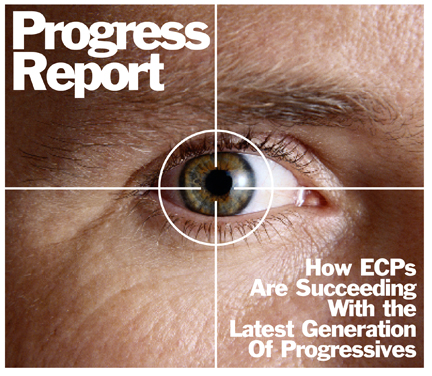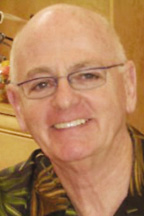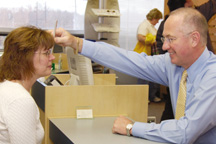
By Roger Mummert
Contributing Editor
NEW YORK--Eyecare practitioners and eyewear dispensers have a compelling growth opportunity before them with latest-generation progressive addition lenses (PALs). PAL manufacturers are using new design and manufacturing technologies such as wavefront and digital surfacing to deliver a higher quality of vision, in some cases "personalized" to the wearer.
The key to succeeding with these products--and the higher prices they command--lies with being able to translate "tech talk" into lay terms, dispensers say. And, when fit well, these products can provide a "wow factor" that makes happy campers of premium progressive lens wearers.
"There aren't many lenses that come along where the patient gets a wow factor, but I actually have had patients put on the Zeiss GT2 and say, "Wow!" said Bruce Kolkmann, optician and owner of Raymond Opticians in Mt. Kisco, N.Y. "I made up a pair for myself, and I looked at some work on the bench, and I said, "Wow!"
Kolkmann has had great success over the past year in fitting the Zeiss GT2 lens, which is produced by Carl Zeiss Vision (CZV). He finds both new and existing PAL wearers welcome the advantages of cutting edge technology, once it is couched in friendly terms.
"I explain that Zeiss has paid extra special attention to natural eye movements and designing a lens that optimizes the reading areas with more viewing throughout the lens surface," Kolkmann said. "There's less unwanted astigmatism that is inherent in all progressive lenses, and you don't see jumps or breaks."
Positioned by CZV as a general purpose PAL, the GT2 is built on the design principles of Zeiss's Gradal Top PAL. The lens features Zeiss's patented Horizontal Symmetry, which offers binocularity in all directions, variable inset to match the individual?s degree of convergence and a wide entrance to the corridor, according to CZV.
CZV has also refined the GT2's design based upon studies of visual ergonomics which led it to shorten the corridor. As a result, the top of the reading area corresponds to the average visual angle of the eyes when reading the first line of text on a printed page. GT2 also delivers up to 50 percent more reading vision than Gradal Top, even at the minimum fitting height of 17mm.
The GT2 is priced at a 20 percent premium over previous generation Zeiss lenses that the shop fit, Kolkmann said, and customers are willing to pay more because they appreciate the upgrade in quality of vision.
Easier Adaptation, Fewer Remakes
"Many limitations of progressive lenses in the past now are solved by today's much improved progressives," said Mike Tiernan, owner of Tiernan Opticians in San Carlos, Calif. He notes that the technology advances embodied by the new PALs, while often challenging to explain in lay terms, boil down to one thing: They provide sharper, clearer vision--and PAL wearers find the new lens designs easier to adapt to than previous PAL designs.
 |
| Mike Tiernan |
Roger Johnson, OD, a solo practitioner in Natrona Heights, Penn., said that with today's better PAL technology, "We've got fewer problems and very few remakes." Johnson relies on a variety of PAL lens designs, but Hoya lenses are among those he most frequently uses.
"The Hoya Summit CD is really a troubleshooting lens, and we've had a lot of success with it, especially with high-index materials in the smaller frames that are popular now," he said. "The Hoya lens, as well as the Kodak Unique and the Varilux Ellipse, really solves a lot ofthe problems we saw with PALs in past years."
Hoya Vision Care has steadily strengthened its PAL product line. The company currently offers six different PAL designs, each geared for different lifestyle applications. Hoyalux Summit progressive lens designs utilize Integrated Transmittance Control (ITC) technology. This proprietary Hoya technology is applied using a 3D computer simulation model along with advanced design verification mapping. Hoya offers a choice of two designs: Summit ECP, which features an 18mm minimum fitting height, and Summit cd, which features a 14mm minimum fitting height. Both lenses offer in-wear customization, which optimizes refraction parameters with wearing positions for superior visual acuity; 120 inset variable for perfect placement of the reading area for maximum viewing performance. Design symmetry for identical balance of nasal and temporal zones for increased viewing comfort.
Hoyalux ID is an integrated, double-surface PAL design. Made with Hoya digital surfacing technology, it separates the performance of the front and back surface of the lens and virtually eliminates swimming and swaying sensations for the wearer, according to Hoya. Other Hoya PALs include Hoyalux GP Wide, a general purpose lens and Hoyalux TACT, an indoor extended focus PAL designed for computer use and other visually intensive tasks.
Solving Individual Needs
James Kershaw, OD, of North Olmstead, Ohio, relies upon Hoya PALs to tailor solutions to individual presbyopic needs. "If you pay attention to what a lens does and what a patient's expectations are, you can have a lot of success," he said.
Kershaw reaches for the HoyaluxSummit CD as his workhorse lens that solves a wide range of problems. In addition, he relies on the Hoyalux GP for presbyopes with a lot of near demand like computer use, and the Summit ECP for patients with more need at distance and intermediate. He personally wears the Hoyalux iD and enjoys its performance.
"There is no one perfect progressive lens," he explained, "so it's nice to have an arsenal to address people who say they've experienced a lot of distortion or haven't been able to adapt to bifocals." Kershaw, who serves a suburban patient base in his 31-year-old practice, keys his presentation to each patient. "If someone appreciates technology, I'll talk about the integration of the front and back surface optics," he said." But generally, people relate when I explain that a new lens design has less peripheral distortion."
 |
| Jim Kershaw, OD, measuring a patient for progressive lenses. |
Kershaw relies on his local lab for technical help, and he said that Hoya's coordination oflens coatings and materials helps to deliver a quality product that commands a premium price. "My patients understand that a premium product commands a premium price," he said.
Other latest-generation lenses incorporate unique features and technologies. For example, the Kodak Unique progressive from Signet Armorlite uses proprietary production technology that automatically customizes the lens design for the patient's frame selection. This ensures the best overall visual performance for any 'B' measurement, large or very small, from 18mm to a 13mm fitting height, according to Signet Armorlite. In addition, Signet has developed a system that synchronizes the front and back surfaces of the lens for "smooth visual performance."
Visual corrections are applied to the back surface of the lens with a process called Digital Resolution Technology, and visual performance is then verified through wavefront technology. No difficult dispensing techniques or special equipment is required, according to Signet Armorlite. With the patient's monocular pupillary distance, fitting height measurements and frame selection the Kodak Unique lens design will be customized for maximum visual performance. Signet Armorlite offers Kodak Unique in 27 lens materials, including 15 photochromic choices, six polarized, and six clear lens options.
 |
| Paul Di Fiore |
"I'm in practice for 21 years, and having seen the degree and range of difficulty with satisfying early presbyopes with progressive lenses, I am just in disbelief with the success I've had with the [Signet Armorlite] Kodak Unique lens," said Paul Di Fiore, OD, of Optique Boutique in Mt. Laurel and Lawrenceville, N.J.
Di Fiore attributes his success to the synchronization feature in the Kodak Unique and to the fact that the lab generates the finished lens with readings of the exact shape of the chosen frame, in addition to regular Rx and measurements. Di Fiore's office faxes a tracing of each lens to the lab.
"There's a tremendous wow factor when a patient tries on their new Unique lenses," said Fiore
Di Fiore insists that ECPs themselves have to take on the task of explaining to patients how well the Kodak Unique lens works. "I explain that this lens goes to the next generation of technology," he said. This helps in patient acceptance of a premium price: Lenses can run $350, up from $275 for other PALs. Di Fiore includes in that price Kodak's anti-static, hydrophobic, AR coating, which he says is excellent. "I also include a complete satisfaction guarantee in that price." In a half year of fitting the lens, he has done only one redo. He also offers the Kodak lens in polycarbonate, high-index plastic and photochromic materials.
PAL Choices Multiply
Shamir Insight employs proprietary Eye-Point Technology to simulate the human eye at various angles of vision. That information is combined with Rx data from the patient and frame choice in generating a personalized PAL through its trademarked Freeform Technology.
Shamir Insight is in the process of upgrading all of its semi-finished PALs to its "Freeform Optics" technology platform, which is used to produce Shamir's Creation PAL. The newest lens to be produced with Freeform Optics is the Shamir Piccolo short-corridor PAL. Two other Shamir PALs--Shamir Office and Shamir Attitude, will soon be available with Freeform Optics as well.
Shamir is also expanding its Autograph line of personalized PALs. Positioned by Shamir as a "lifestyle" lens, the Autograph design is created using a patient's specific prescription, frame measurement, pupil distance and seg height.
The technology gives Shamir Autograph optical accuracy up to 1/100 diopters, according to Shamir. Shamir currently has two Autograph lenses available to order. The original Autograph design, which is recommended for the everyday wearer, is classified as a general purpose lens with a fitting height of 19mm. The Autograph-Fashion, which has a 16mm fitting height, is made specifically for those who enjoy wearing small, contemporary frames. Additional Autograph lifestyle lenses will be released throughout the year including Occupation and Sport designs. Shamir also plans to release Autograph single-vision lenses, broadening its product line to include patients whose needs are not specific to presbyopia.
Shamir Insight now offers a Freeform certification program to its partnering labs and ECPs interested in boosting their sales of the Shamir Autograph and Shamir Creation progressive lenses. The program consists of a day-long training program where attendees learn the history, terminology, technology and process of Freeform Technology and the Shamir Freeform Family of lenses. Upon completion of the certification process, participants will be listed as a Freeform Certified Lab or ECP on Shamir's Web site, and will receive a Freeform Certified certificate and decal to post in their lab or practice as well as receiving sales aids and many other benefits.
"I'm wearing the new Creation lens from Shamir, and when I put it on I noticed a definite improvement over the Genesis lens from Shamir that I was wearing before," said Giovanni Passamonti, an optician at Mazzuca Eye and Laser Center, Inc., in Salem, N.J. Both he and the owner of the practice wear progressive lenses by Shamir, which he calls state-of-the-art in Freeform Technology. "For me, it's almost like wearing a single-vision lens with very little distortion and good peripheral vision." When he fits patients with the lens, they often remark that they have crisper vision than what they had before. "My patients notice a difference," he said.
Passamonti added that he positions the Shamir Creation at a good price point for his practice: $249.95 a pair. He also said that the lens is very flexible, accommodating a variety of styles of head and eye movements.
In addition to the Creation, Passamonti fits the Shamir Piccolo for short-corridor lenses. Once again, he can dispense with confidence. "The owner of the practice, an ophthalmologist, wears the Piccolo and is very happy with the lens."
Several other PAL suppliers have recently introduced new, digitally-surfaced products in the U.S. market. These lenses are just beginning to come to the attention of ECPs.
Seiko Optical Products of America is expanding its portfolio of progressive addition lenses (PALs) with the release this month of the Seiko Succeed Internal Free-Form, a digitally surfaced progressive that features a 100 percent back-surface design.
Although Seiko had previously introduced a back-surface PAL, the Proceed Internal Progressive, that lens is made in Japan and is only available in the U.S. on a special-order basis from Seiko. The Succeed Internal Free-Form is being distributed through select U.S. wholesale laboratories equipped with digital or direct surfacing technology to process the lens.
Seiko Succeed Internal Free-Form lenses utilize technology invented and patented by Seiko Epson, which pioneered backside PAL designs in the 1990s. The technology places the patient's entire Rx onto the back surface of the lens, leaving the front surface a perfect sphere. This alleviates the "swim and sway" effect caused when the progressive power is on the front surface, and effectively eliminates non-adapts. It also significantly expands the fields of view, since the corrective surface is placed closer to the eye, the company said.
Seiko Internal Free-Form lenses are custom made to each patient's prescription using the latest surfacing equipment. Aspheric compensation is calculated for each sphere, cylinder, axis and prism in each visual field, taking into account eye rotation and the change in vertex distance. This allows for total management of off-center astigmatism and power error, another cause of non-adapts.
Succeed Internal Free-Form lenses are available from authorized Seiko distributors in a variety of materials and coatings, including 1.67, poly and plastic, and Transitions lenses. A polarized version of the lens will be available in standard plastic and 1.67 beginning in May.
Indo Lens U.S. is also introducing digitally-surfaced PALs in the U.S. under the umbrella of "Free-form Solutions." The company offers two "global designs," a multi-purpose PAL designs in 22mm regular corridor with a soft design and a 16mm short corridor, which optimized and specialized for small frames with a fitting height of 16mm or more.
Indo also offers several "action designs" to meet specific visual needs. These include a "PC design" for indoor working environments; a "road design," which has been developed for far and intermediate distances and improves the vision quality of backwards driving or using the rear-view mirror, and an "outdoors design" optimized for outdoor activities. In addition, Indo offers "FreeDesign" PAL designs based on characteristics and parameters provided by the patient. This design will be created by Indo's R&D division upon demand and exclusively marketed by the lab who requested its development.
Vision-Ease Lens is also expanding its PAL product offering. The company recently announced a licensing and distribution agreement with Optixx, a progressive lens company based in Switzerland. With the portfolio of progressive designs from Optixx, Vision-Ease Lens is now able to offer new traditionally surfaced progressive lenses and direct-surfaced progressives to its customers.











